The Effects of Roof and Wall Insulation on the Energy Costs of Low Income Housing in Mexico
Abstract
:1. Introduction
1.1. Energy Use for Climate Control in Buildings
1.2. Optimal Thickness of Thermal Insulation
1.3. Combined Effect of Solar Reflectance and Thermal Insulation in Roofs
1.4. The State of Building Insulation and Previous Studies in Mexico
2. Methods
2.1. Description of the Base Case
2.2. Economic Analysis
3. Results
3.1. Energy Savings
3.2. Cost-Benefit Analysis
4. Conclusions
Acknowledgments
Author Contributions
Conflicts of Interest
Abbreviations
| Ains | Total insulated surface area |
| CDD | Cooling degree-days |
| Ce, base | Electricity cost in the base case |
| Ce, ins | Electricity cost in the case with thermal insulation |
| Ce, prod | Energy cost based on the cost of electrical production |
| Ce, sub | Energy cost based on subsidized price of electricity |
| Cins | Total initial cost of insulation |
| Cinst | Cost of installing thermal insulation |
| Cmat | Cost of the insulating material |
| Ecool | Electricity consumption for space cooling |
| Eheat | Electricity consumption for space heating |
| HDD | Heating degree-days |
| L | Thickness of thermal insulation |
| NPS | Net present saving |
| NMX (Norma Mexicana) | non-mandatory federal standard |
| NOM (Norma Oficial Mexicana) | mandatory federal standard |
| NMX-C-460 (NMX-C-460-ONNCCE-2009) | non-mandatory building standard |
| NOM-020 (NOM-020-ENER-2011) | mandatory building standard |
| Pnon-summer | Expected price for the non-summer period |
| Pprod | Price based on electricity cost production |
| Psummer | Expected price for the summer period |
| PWF | Present worth factor |
| Se | Annual electrical cost savings |
References
- United State Departament of Energy. 2011 Buildings Energy Data Book. Available online: http://buildingsdatabook.eren.doe.gov/docs/DataBooks/2011_BEDB.pdf (accesed on 9 May 2016).
- Europa Union. EU Energy in Figures Statistical Pocketbook 2015. Available online: https://ec.europa.eu/energy/en/statistics/energy-statistical-pocketbook (accesed on 9 May 2016).
- Secretaria de energía. Balance Nacional de Energía 2014. Available online: http://www.gob.mx/cms/uploads/attachment/file/44353/Balance_Nacional_de_Energ_a_2014.pdf (accessed on 22 February 2016).
- Oropeza-Perez, I.; Ostergaard, P.A. Energy saving potential of utilizing natural ventilation under warm conditions—A case study of Mexico. Appl. Energy 2014, 130, 20–32. [Google Scholar] [CrossRef]
- Rosas-Flores, J.A.; Rosas-Flores, D.; Gálvez, D.M. Saturation, energy consumption, CO2 emission and energy efficiency from urban and rural households appliances in Mexico. Energy Build. 2011, 43, 10–18. [Google Scholar] [CrossRef]
- Akbari, H.; Konopacki, S.; Pomerantz, M. Cooling energy savings potential of reflective roofs for residential and commercial buildings in the United States. Energy 1999, 24, 391–407. [Google Scholar] [CrossRef]
- Bolattürk, A. Optimum insulation thicknesses for building walls with respect to cooling and heating degree-hours in the warmest zone of Turkey. Build. Environ. 2008, 43, 1055–1064. [Google Scholar] [CrossRef]
- Gentle, A.R.; Aguilar, J.L.C.; Smith, G.B. Optimized cool roofs: Integrating albedo and thermal emittance with R-value. Sol. Energy Mater. Sol. Cells 2011, 95, 3207–3215. [Google Scholar] [CrossRef]
- Shi, Z.; Zhang, X. Analyzing the effect of the longwave emissivity and solar reflectance of building envelopes on energy-saving in buildings in various climates. Sol. Energy 2011, 85, 28–37. [Google Scholar] [CrossRef]
- Kaynakli, O. A review of the economical and optimum thermal insulation thickness for building applications. Renew. Sustain. Energy Rev. 2012, 16, 415–425. [Google Scholar] [CrossRef]
- Rodríguez-Soria, B.; Domínguez-Hernández, J.; Pérez-Bella, J.M.; del Coz-Díaz, J.J. Review of international regulations governing the thermal insulation requirements of residential buildings and the harmonization of envelope energy loss. Renew. Sustain. Energy Rev. 2014, 34, 78–90. [Google Scholar] [CrossRef]
- Akbari, H.; Levinson, R. Evolution of cool-roof standards in the US. Adv. Build. Energy Res. 2008, 2, 1–32. [Google Scholar] [CrossRef]
- Akbari, H.; Matthews, H.D. Global cooling updates: Reflective roofs and pavements. Energy Build. 2012, 55, 2–6. [Google Scholar] [CrossRef]
- Nowak, H. The longwave radiative heat transfer of the building envelopes. Infrared Phys. 1991, 32, 357–363. [Google Scholar] [CrossRef]
- Chwieduk, D.A. Recommendation on modelling of solar energy incident on a building envelope. Renew. Energy 2009, 34, 736–741. [Google Scholar] [CrossRef]
- Kaşka, Ö.; Yumrutaş, R. Experimental investigation for total equivalent temperature difference (TETD) values of building walls and flat roofs. Energy Convers. Manag. 2009, 50, 2818–2825. [Google Scholar] [CrossRef]
- Emmel, M.G.; Abadie, M.O.; Mendes, N. New external convective heat transfer coefficient correlations for isolated low-rise buildings. Energy Build. 2007, 39, 335–342. [Google Scholar] [CrossRef]
- Palyvos, J. A. A survey of wind convection coefficient correlations for building envelope energy systems’ modeling. Appl. Therm. Eng. 2008, 28, 801–808. [Google Scholar] [CrossRef]
- Sisman, N.; Kahya, E.; Aras, N.; Aras, H. Determination of optimum insulation thicknesses of the external walls and roof (ceiling) for Turkey’s different degree-day regions. Energy Policy 2007, 35, 5151–5155. [Google Scholar] [CrossRef]
- Simpson, J.R.; McPherson, E.G. The effects of roof albedo modification on cooling loads of scale model residences in Tucson, Arizona. Energy Build. 1997, 25, 127–137. [Google Scholar] [CrossRef]
- Synnefa, A.; Santamouris, M.; Akbari, H. Estimating the effect of using cool coatings on energy loads and thermal comfort in residential buildings in various climatic conditions. Energy Build. 2007, 39, 1167–1174. [Google Scholar] [CrossRef]
- Lucero-Álvarez, J.; Alarcón-Herrera, M.T.; Martin-Domínguez, I.R. The effect of solar reflectance, infrared emissivity, and thermal insulation of roofs on the annual thermal load of single-family households in México. In Proccedings of the EuroSun, Aix-Les-Bains, France, 16–19 September 2014.
- Griego, D.; Krarti, M.; Hernandez-Guerrero, A. Energy efficiency optimization of new and existing office buildings in Guanajuato, Mexico. Sustain. Cities Soc. 2015, 17, 132–140. [Google Scholar] [CrossRef]
- Álvarez-García, G.S.; Shah, B.; Rubin, F.; Gilbert, H.; Martin-Domínguez, I.R.; Shickman, K. Evaluación del impacto del uso de “Cool Roof” en el ahorro de energía en edificaciones no-residenciales y residencial en México. Available online: http://www.cleanenergyministerial.org/Portals/2/pdfs/GSEP-CoolRoofs-InformeCoolRoofsCONUEE-Mayo-22-2014-Espanol.pdf (accessed on 18 February 2016). (In Spanish)
- Méndez-Florián, F.; Velasco-Sodi, P.; Gabilondo, A.I.; Galindo, R.; López-Silva, M. Estrategia Nacional para la vivienda sustentable. Available online: http://fundacionidea.org.mx/assets/files/F.IDEA_Estrategia%20vivienda%20sustentable%20_130311_FINAL.pdf (accessed on 19 May 2016). (In Spanish)
- Day, T. Degree-Days: Theory and Application; Chartered Institution of Building Services Engineers (CIBSE): London, UK, 2006. [Google Scholar]
- De Rosa, M.; Bianco, V.; Scarpa, F.; Tagliafico, L.A. Heating and cooling building energy demand evaluation, a simplified model and a modified degree days approach. Appl. Energy 2014, 128, 217–229. [Google Scholar] [CrossRef]
- Almada-N., D.V.; Yeomans-R., F.S.; Nungaray Perez, C.E.; Hernandez Cordova, V.G. Monitoreo de Viviendas con Criterios de Ahorro Energético. In Ninth LACCEI Latin American and Caribbean Conference (LACCEI’2011), Engineering for a Smart Planet, Innovation, Information Technology and Computational Tools for Sustainable Development, Medellín, DC, USA, 3–5 August 2011. (In Spanish)
- Calderón, R.; Arredondo, J.A.; Gallegos, R.; Mayagoitia, F. Reducción del Consumo Eléctrico y CO2 mediante Sistemas de Ahorro y de Aislamiento Térmico aplicados a Viviendas en Zonas Áridas de México. Inform. Tec. 2011, 22, 69–78. (In Spanish) [Google Scholar]
- Campos, A.L. Estudio de optimización de la eficiencia energética en viviendas de interés social. Programa de Energía Sustentable en México, componente edificación, GIZ. Available online: http://idbdocs.iadb.org/wsdocs/getdocument.aspx?docnum=36288713 (accessed on 20 August 2015). (In Spanish).
- Solís, D. Análisis térmico de una vivienda económica en clima cálido-seco bajo diferentes orientaciones y medidas de sombreado. Estud. sobre Arquit. y Urban. del Des. 2010, 3, 31–57. (In Spanish) [Google Scholar]
- Heard, Ch.L.; Olivera-Villarroel, S.M. Evaluación económica de la resistencia térmica de la vivienda de interés social en las ciudades tropicales de México. Acta Univ. UGt. 2013, 23, 17–29. (In Spanish) [Google Scholar]
- Griego, D.; Krarti, M.; Hernandez-Guerrero, A. Optimization of energy efficiency and thermal comfort measures for residential buildings in Salamanca, Mexico. Energy Build. 2012, 54, 540–549. [Google Scholar] [CrossRef]
- Gobierno de los Estados Unidos Mexicanos. Anexo Estadístico del Tercer Informe de Gobierno 2014–2015. Available online: http://www.presidencia.gob.mx/tercerinforme/ (accessed on 21 January 2016). (In Spanish)
- Secretaria de Hacienda y Crédito Público (SHCP). Acuerdo 15/2014: Acuerdo por el que se establecen las tarifas finales de energía eléctrica del suministro básico a usuarios domésticos. Available online: http://www.dof.gob.mx/nota_detalle.php?codigo=5377946&fecha=01/01/2015 (accessed on 21 January 2016). (In Spanish)
- Secretaria de Hacienda y Crédito Público (SHCP). Acuerdo 27/2015: Acuerdo por el que se autoriza ajustar tarifas finales de energía eléctrica del suministro básico a usuarios domésticos. Available online: http://www.dof.gob.mx/nota_detalle.php?codigo=5421731&fecha=30/12/2015 (accessed on 21 January 2016). (In Spanish)
- Banco de México. Tipos de cambio y resultados históricos de las subastas. Available online: http://www.banxico.org.mx/SieInternet/consultarDirectorioInternetAction.do?accion=consultarCuadro&idCuadro=CF86§or=6&locale=es (accessed on 24 February 2016). (In Spanish)
- Ozel, M. Effect of wall orientation on the optimum insulation thickness by using a dynamic method. Appl. Energy 2011, 88, 2429–2435. [Google Scholar] [CrossRef]
- Santin, O.G. Environmental Indicator for Building Design: Development and applications on Mexican Dwellings; IOS Press: Nieuwe Hemweg, Netherlands, 2008. [Google Scholar]
- Davis, L.W.; Gertler, P.J. Contribution or air conditioning adoption to future energy use under global warming. Proc. Nati. Acad. Sci. 2015, 112, 5962–5967. [Google Scholar] [CrossRef] [PubMed]
- Sistema Meteorológico Nacional. Normales climatológicas 1981–2000. Available online: http://smn.cna.gob.mx/es/component/content/article?id=42 (accessed 15 June 2016). (In Spanish)
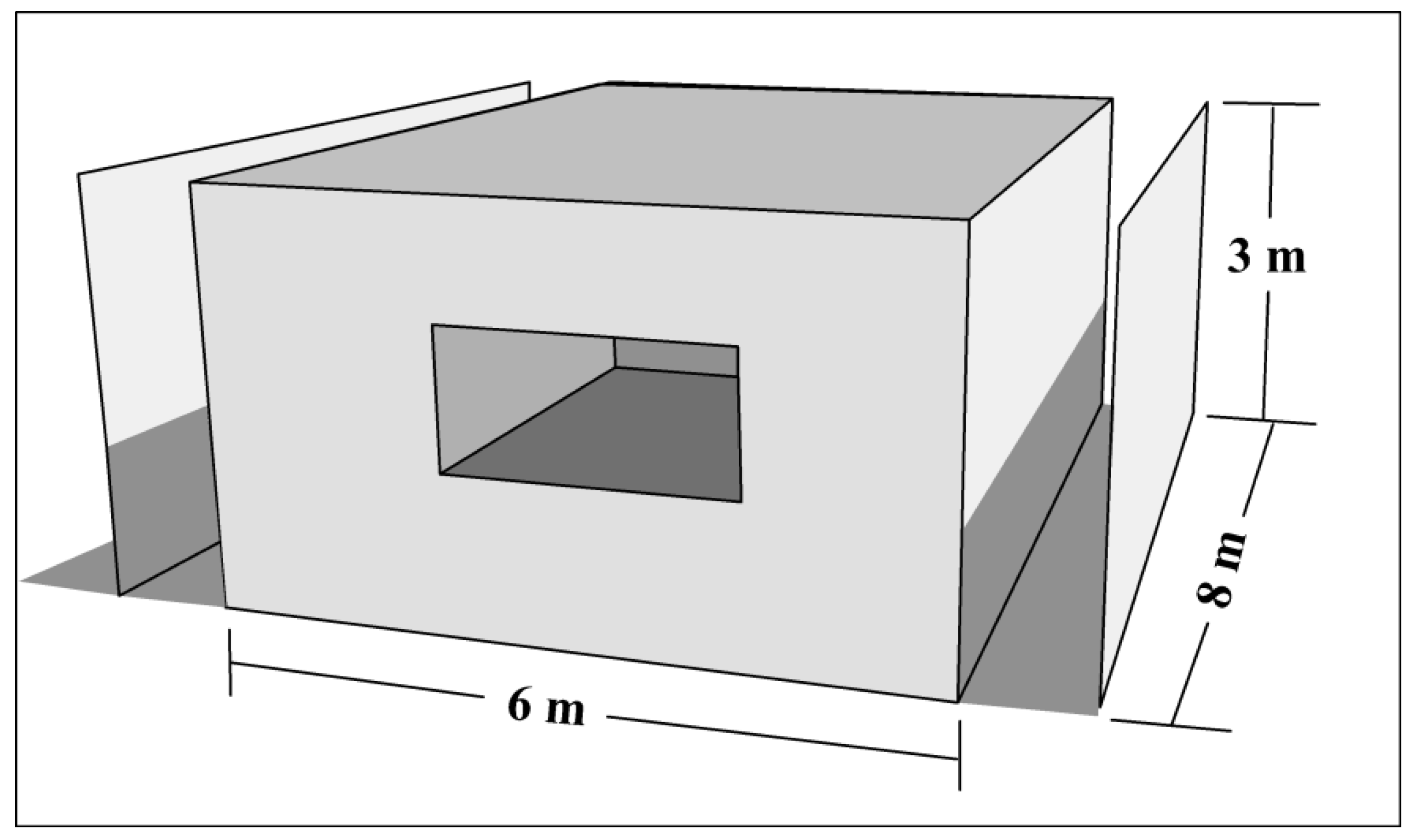


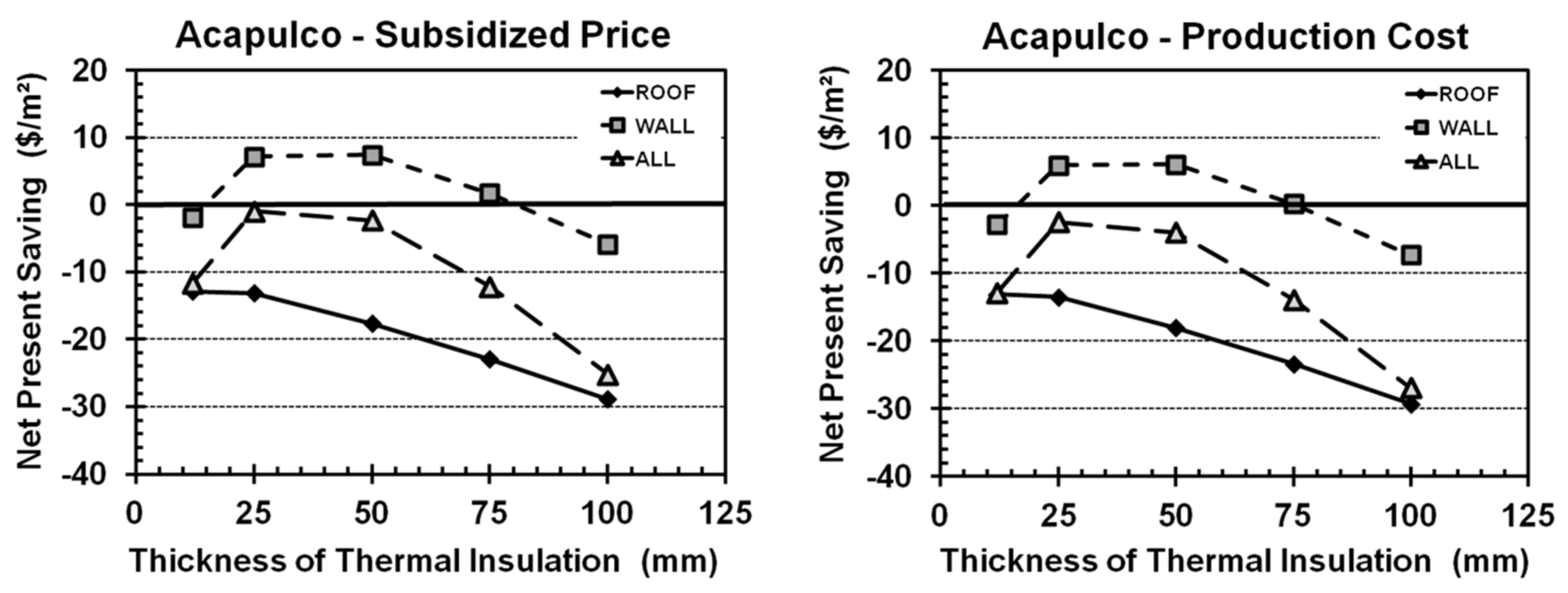
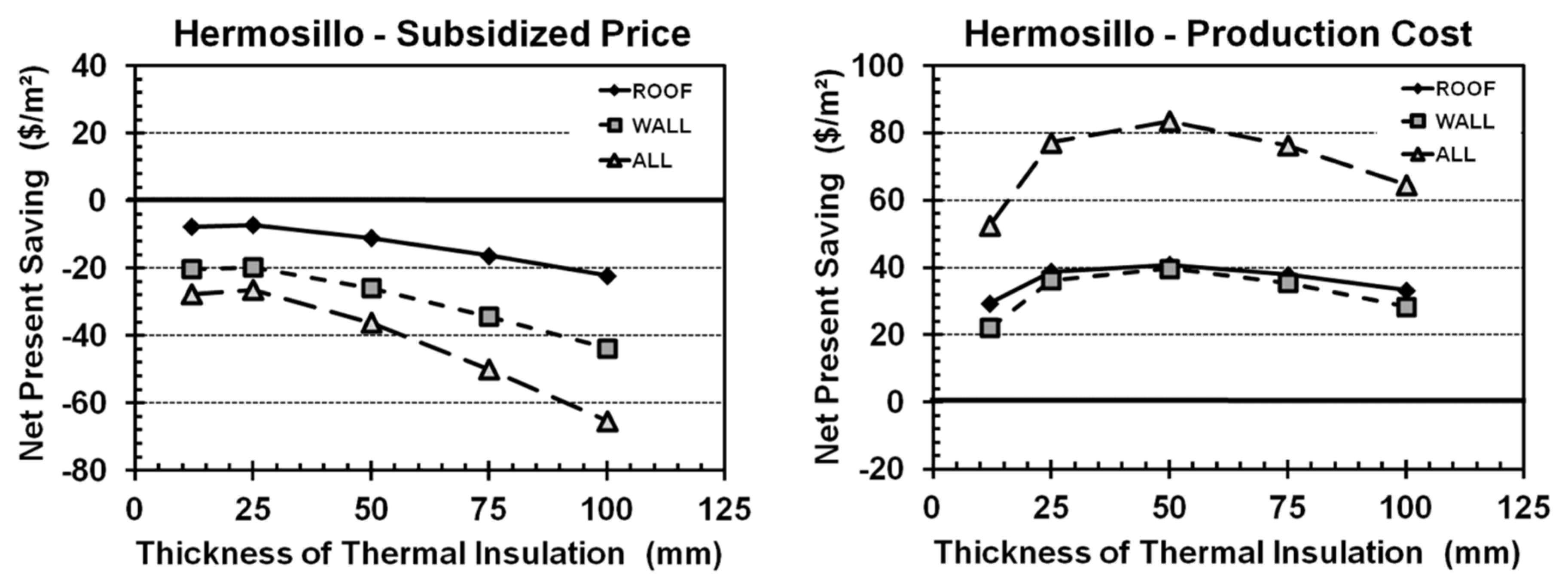
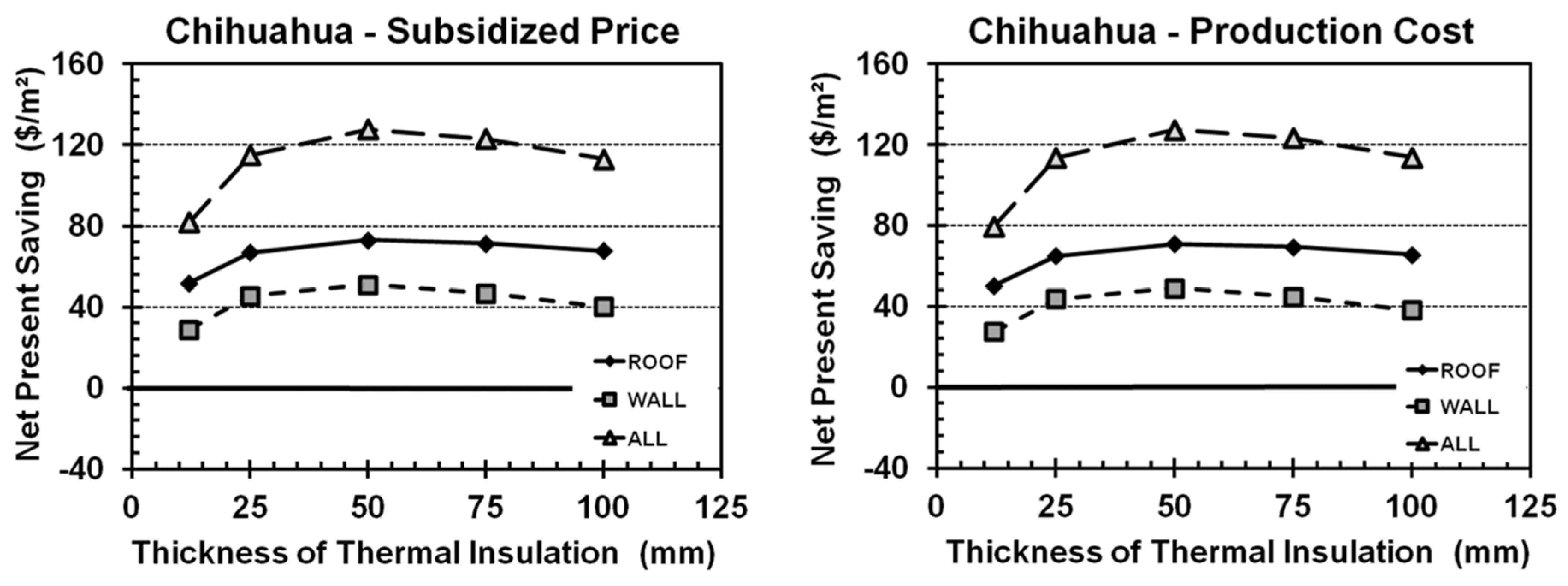

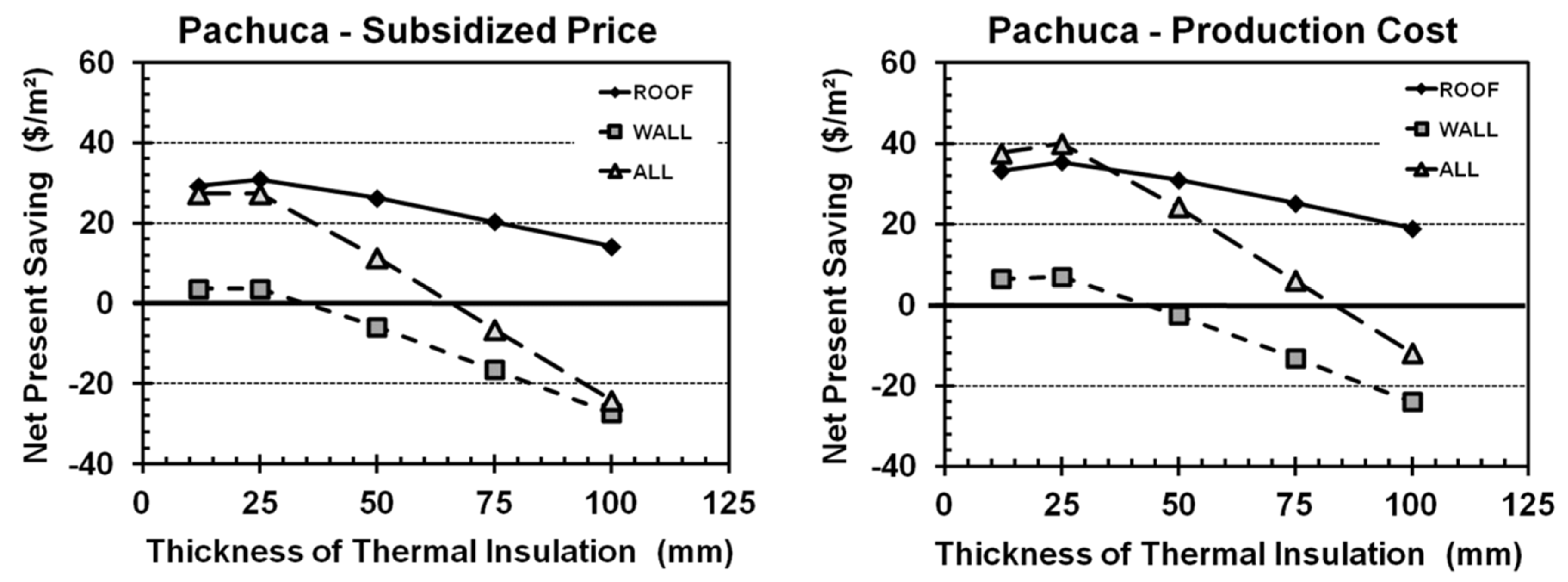

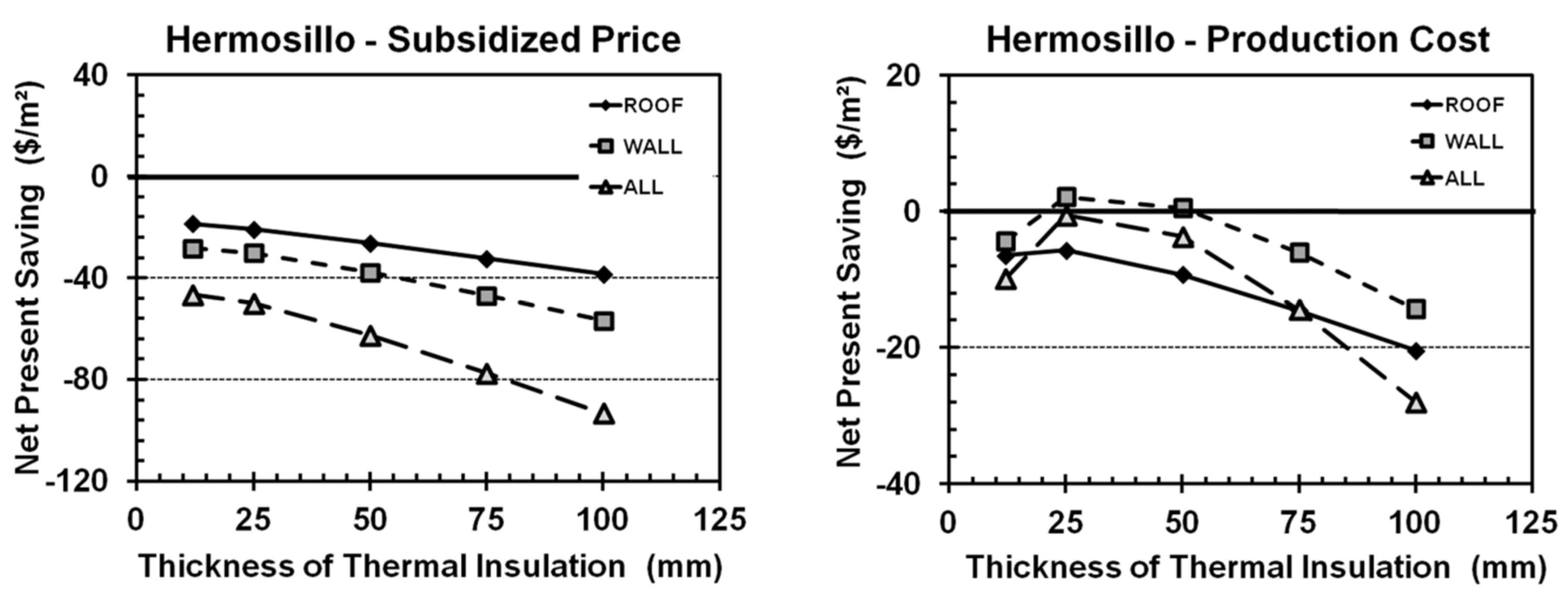
| Climate Zones | Cooling Degree-Days per Year (CDD10) | Heating Degree‑Days per Year (HDD18) | Type of Region |
|---|---|---|---|
| 1 | >5000 | Low elevation, tropical and arid-warm | |
| 2 | 3500–5000 | Sub-tropical and arid-dry | |
| 3 1 | 2500–3500 | <3000 | Mexican Plateau, semi-arid and temperate |
| 4 1 | <2500 | >2000 | Semi-arid and temperate, cold winters |
| Reference | Method | Building Area | Comparison | Results by City 1 (kWh/year) |
|---|---|---|---|---|
| Almada-N. et al., 2011 * [28] | Power consumption monitoring | 38.4 m² | Base case vs. thermal insulation on roof, efficient A/C equipment and illumination. Annual power consumption (A/C equipment + illumination + appliances) | Base case: Mexicali 6044. With thermally-insulated roof and efficient case: Mexicali from 3835–7629. |
| Calderon et al., 2011 * [29] | Simulation DOE v2.1 | 38 m² | Base case vs. thermal insulation on roof, efficient A/C equipment and illumination | Base case: Mexicali 3778; Hermosillo 3648; Obregon 3628. Efficient case: Mexicali 1945; Hermosillo 1850; Obregon 1776. |
| Campos, 2011 [30] | Simulation Energy Plus v6 | 44.7 m² | Base case vs. diverse strategies (thermal insulation, double pane windows, reflective coatings) | Base case: Hidalgo state 1922; Puebla 1296; Monterrey 3889; Hermosillo 6347; Merida 5140; Cancun 4201. |
| Solis, 2010 [31] | Simulation EnergyPlus v2.1 | 32.6 m² | Base case vs. different wall orientations and shading strategies | Base case: Hermosillo 17,904, Nuevo Laredo 18,490; Monterrey 17,741; Torreon 13,320; Mexicali 12,205, Chihuahua 8767. |
| Heard et al., 2013 * [32] | Simulation DOE v2 | 52 m² (two levels) | Base cases vs. thermal insulation on opaque envelope (walls + roof) | Base case: Mexicali 9811; Monterrey 6235; Mexico City 2130; Merida 7702; Villahermosa 9574; Juarez 4930; Matamoros 6216, Nuevo Laredo 7984. Energy saving by 16 mm of thermal insulation: Mexicali 4181; Monterrey 6235; Mexico City 402; Merida 7702; Villahermosa 2782; Juarez 1995; Matamoros 6216; Nuevo Laredo 2988. |
| City (Thermal Zone) | Solar reflectance of Walls | Solar reflectance of Roofs | Infrared emissivity of Roofs |
|---|---|---|---|
| Acapulco (1) | 0.7 | 0.9 | 0.9 |
| Hermosillo (2) | 0.7 | 0.9 | 0.9 |
| Chihuahua (3) | 0.7 | 0.5 | 0.9 |
| Mexico City (3) | 0.7 | 0.5 | 0.9 |
| Pachuca (4) | 0.7 | 0.1 | 0.9 |
| Toluca (4) | 0.7 | 0.1 | 0.9 |
| Case | Roof | Wall | ||
|---|---|---|---|---|
| m²·K/W | ft²·°F·h/Btu | m²·K/W | ft²·°F·h/Btu | |
| Base case | 0.15 | 0.86 | 0.25 | 1.41 |
| ROOF12 | 0.58 | 3.29 | 0.25 | 1.41 |
| ROOF25 | 1.04 | 5.93 | 0.25 | 1.41 |
| ROOF50 | 1.94 | 11.00 | 0.25 | 1.41 |
| ROOF75 | 2.83 | 16.07 | 0.25 | 1.41 |
| ROOF100 | 3.72 | 21.14 | 0.25 | 1.41 |
| WALL12 | 0.15 | 0.86 | 0.68 | 3.84 |
| WALL25 | 0.15 | 0.86 | 1.14 | 6.48 |
| WALL50 | 0.15 | 0.86 | 2.03 | 11.55 |
| WALL75 | 0.15 | 0.86 | 2.93 | 16.62 |
| WALL100 | 0.15 | 0.86 | 3.82 | 21.69 |
| ALL12 | 0.58 | 3.29 | 0.68 | 3.84 |
| ALL25 | 1.04 | 5.93 | 1.14 | 6.48 |
| ALL50 | 1.94 | 11.00 | 2.03 | 11.55 |
| ALL75 | 2.83 | 16.07 | 2.93 | 16.62 |
| ALL100 | 3.72 | 21.14 | 3.82 | 21.69 |
| City | Price Category | Basic | Medium | High Medium | Excess | |
|---|---|---|---|---|---|---|
| Non-Summer Season | ||||||
| Acapulco (November–April) | 1B | Usage (kWh/month) | 0–75 | 76–175 | >175 | |
| Price (US$/kWh) | 0.0501 | 0.0615 | 0.1803 | |||
| Hermosillo (November–April) | 1F | Usage (kWh/month) | 0–75 | 76–200 | >200 | |
| Price (US$/kWh) | 0.0501 | 0.0615 | 0.1803 | |||
| Chihuahua (October–March) | 1B | Usage (kWh/month) | 0–75 | 76–175 | >175 | |
| Price (US$/kWh) | 0.0501 | 0.0615 | 0.1803 | |||
| Mexico City (September–February) | 1 | Usage (kWh/month) | 0–75 | 76–140 | >140 | |
| Price (US$/kWh) | 0.0501 | 0.0615 | 0.1803 | |||
| Pachuca (September–February) | 1 | Usage (kWh/month) | 0–75 | 76–140 | >140 | |
| Price (US$/kWh) | 0.0501 | 0.0615 | 0.1803 | |||
| Toluca (October–March) | 1 | Usage (kWh/month) | 0–75 | 76–140 | >140 | |
| Price (US$/kWh) | 0.0501 | 0.0615 | 0.1803 | |||
| Summer Season | ||||||
| Acapulco (May–October) | 1B | Usage (kWh/month) | 0–125 | 126–225 | >226 | |
| Price (US$/kWh) | 0.0448 | 0.0529 | 0.1803 | |||
| Hermosillo (May–October) | 1F | Usage (kWh/month) | 0–300 | 301–1200 | 1201–2500 | >2500 |
| Price (US$/kWh) | 0.0375 | 0.0467 | 0.1137 | 0.1803 | ||
| Chihuahua (April–September) | 1B | Usage (kWh/month) | 0–125 | 126–225 | >226 | |
| Price (US$/kWh) | 0.0448 | 0.0529 | 0.1803 | |||
| Mexico City (March–August) | 1 | Usage (kWh/month) | 0–75 | 76–140 | >140 | |
| Price (US$/kWh) | 0.0510 | 0.0615 | 0.1803 | |||
| Pachuca (March–August) | 1 | Usage (kWh/month) | 0–75 | 76–140 | >140 | |
| Price (US$/kWh) | 0.0510 | 0.976 | 0.1803 | |||
| Toluca (April–September) | 1 | Usage (kWh/month) | 0–75 | 76–140 | >140 | |
| Price (US$/kWh) | 0.0510 | 0.976 | 0.1803 | |||
| Case | Acapulco | Chihuahua | Hermosillo | Mexico City | Pachuca | Toluca |
|---|---|---|---|---|---|---|
| Base Case | 123 | 125 | 116 | 33 | 50 | 73 |
| ROOF12 | 120 | 105 | 102 | 24 | 35 | 58 |
| ROOF25 | 119 | 101 | 99 | 23 | 33 | 56 |
| ROOF50 | 119 | 97 | 97 | 22 | 33 | 56 |
| ROOF75 | 118 | 96 | 96 | 21 | 33 | 55 |
| ROOF100 | 118 | 95 | 96 | 21 | 33 | 55 |
| WALL12 | 113 | 107 | 100 | 26 | 38 | 52 |
| WALL25 | 110 | 102 | 95 | 25 | 36 | 47 |
| WALL50 | 107 | 98 | 92 | 25 | 36 | 44 |
| WALL75 | 106 | 96 | 90 | 25 | 36 | 43 |
| WALL100 | 105 | 95 | 89 | 25 | 36 | 43 |
| ALL12 | 110 | 88 | 86 | 19 | 23 | 37 |
| ALL25 | 105 | 77 | 78 | 18 | 21 | 29 |
| ALL50 | 101 | 69 | 72 | 20 | 20 | 26 |
| ALL75 | 99 | 65 | 69 | 21 | 21 | 25 |
| ALL100 | 98 | 63 | 68 | 21 | 21 | 25 |
| Case | Average Price | ||||||
|---|---|---|---|---|---|---|---|
| Initial Cost of Thermal Insulation | Acapulco 1B | Hermosillo 1F | Chihuahua 1B | Mexico City 1 | Pachuca 1 | Toluca 1 | |
| US$ | US$/kWh | US$/kWh | US$/kWh | US$/kWh | US$/kWh | US$/kWh | |
| Base case | 0.00 | 0.1402 | 0.0527 | 0.1420 | 0.1222 | 0.1412 | 0.1395 |
| ROOF12 | 1145.21 | 0.1386 | 0.0517 | 0.1297 | 0.1058 | 0.1243 | 0.1220 |
| ROOF25 | 1303.88 | 0.1382 | 0.0515 | 0.1260 | 0.1026 | 0.1222 | 0.1194 |
| ROOF50 | 1609.03 | 0.1379 | 0.0513 | 0.1232 | 0.1006 | 0.1214 | 0.1180 |
| ROOF75 | 1914.17 | 0.1377 | 0.0512 | 0.1221 | 0.0998 | 0.1212 | 0.1176 |
| ROOF100 | 2219.32 | 0.1377 | 0.0511 | 0.1215 | 0.0994 | 0.1211 | 0.1173 |
| WALL12 | 1855.24 | 0.1346 | 0.0516 | 0.1312 | 0.1100 | 0.1285 | 0.1113 |
| WALL25 | 2112.29 | 0.1321 | 0.0511 | 0.1269 | 0.1078 | 0.1265 | 0.1013 |
| WALL50 | 2606.63 | 0.1301 | 0.0508 | 0.1235 | 0.1073 | 0.1262 | 0.0947 |
| WALL75 | 3100.96 | 0.1292 | 0.0506 | 0.1221 | 0.1074 | 0.1263 | 0.0924 |
| WALL100 | 3595.30 | 0.1287 | 0.0505 | 0.1212 | 0.1075 | 0.1265 | 0.0914 |
| ALL12 | 3000.45 | 0.1321 | 0.0502 | 0.1136 | 0.0938 | 0.1047 | 0.0706 |
| ALL25 | 3416.18 | 0.1285 | 0.0491 | 0.0998 | 0.0925 | 0.0981 | 0.0631 |
| ALL50 | 4215.66 | 0.1253 | 0.0487 | 0.0871 | 0.0958 | 0.0975 | 0.0620 |
| ALL75 | 5015.14 | 0.1238 | 0.0487 | 0.0810 | 0.0982 | 0.0985 | 0.0617 |
| ALL100 | 5814.62 | 0.1230 | 0.0487 | 0.0773 | 0.0997 | 0.0993 | 0.0615 |
| Price variation: | 0.0172 | 0.0040 | 0.0647 | 0.0297 | 0.0437 | 0.0780 | |
| City (Climate Zone) | NOM-020 1 Wall and Roof Reference Building | NMX-C-460 Wall Minimum (Energy Savings) | NMX-C-460 Roof Minimum (Energy Savings) | This work 2 Wall Optimal Case | This work 2 Roof Optimal Case |
|---|---|---|---|---|---|
| Acapulco (1) | 1.90 | 1.00 (1.40) | 1.40 (2.65) | 1.14 | 0.15 |
| Hermosillo (2) | 2.10 | 1.00 (1.40) | 1.40 (2.65) | 1.14 | 0.15 |
| Chihuahua (3) | 1.60 | 1.00 (1.80) | 1.40 (2.80) | 2.03 | 1.94 |
| Mexico City (3) | 1.10 | 1.00 (1.80) | 1.40 (2.80) | 0.25 | 1.04 |
| Pachuca (4) | 1.10 | 1.00 (2.10) | 1.40 (3.20) | 1.14 | 1.04 |
| Toluca (4) | 1.10 | 1.00 (2.10) | 1.40 (3.20) | 1.14 | 1.04 |
© 2016 by the authors; licensee MDPI, Basel, Switzerland. This article is an open access article distributed under the terms and conditions of the Creative Commons Attribution (CC-BY) license (http://creativecommons.org/licenses/by/4.0/).
Share and Cite
Lucero-Álvarez, J.; Rodríguez-Muñoz, N.A.; Martín-Domínguez, I.R. The Effects of Roof and Wall Insulation on the Energy Costs of Low Income Housing in Mexico. Sustainability 2016, 8, 590. https://doi.org/10.3390/su8070590
Lucero-Álvarez J, Rodríguez-Muñoz NA, Martín-Domínguez IR. The Effects of Roof and Wall Insulation on the Energy Costs of Low Income Housing in Mexico. Sustainability. 2016; 8(7):590. https://doi.org/10.3390/su8070590
Chicago/Turabian StyleLucero-Álvarez, Jorge, Norma A. Rodríguez-Muñoz, and Ignacio R. Martín-Domínguez. 2016. "The Effects of Roof and Wall Insulation on the Energy Costs of Low Income Housing in Mexico" Sustainability 8, no. 7: 590. https://doi.org/10.3390/su8070590






